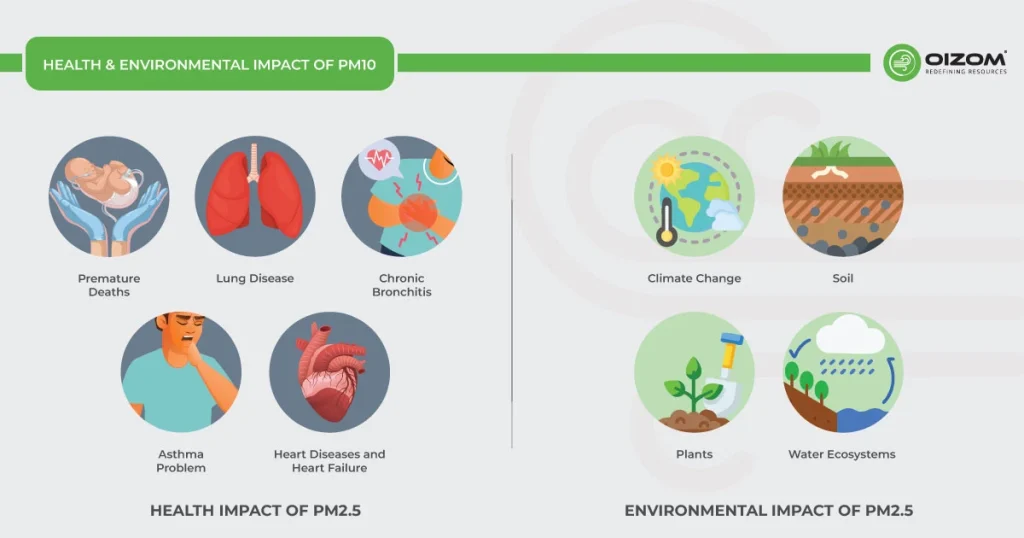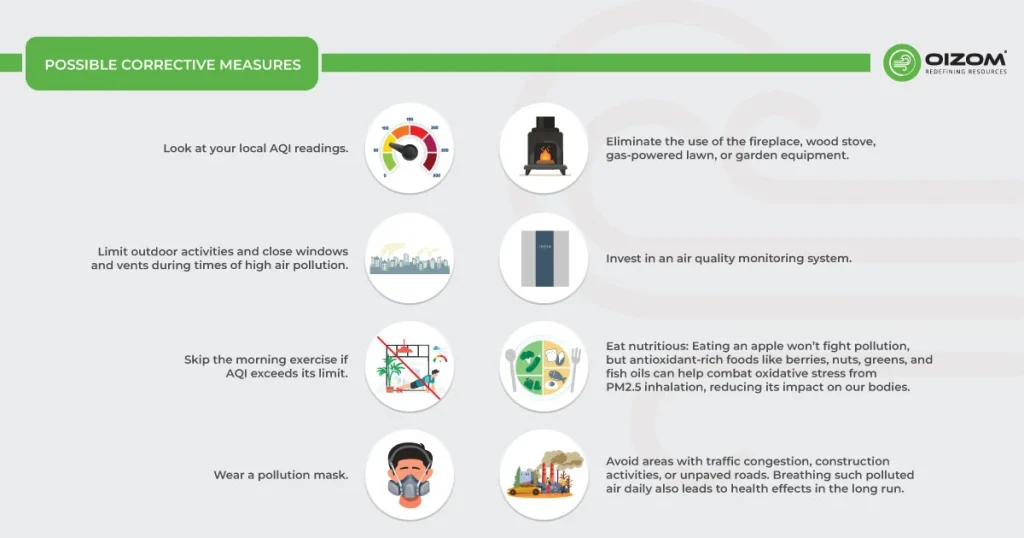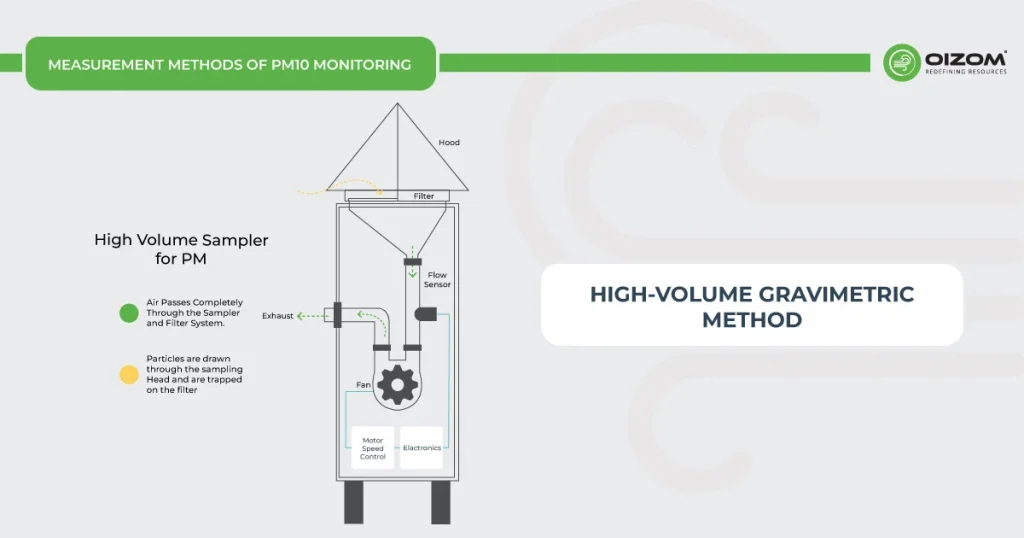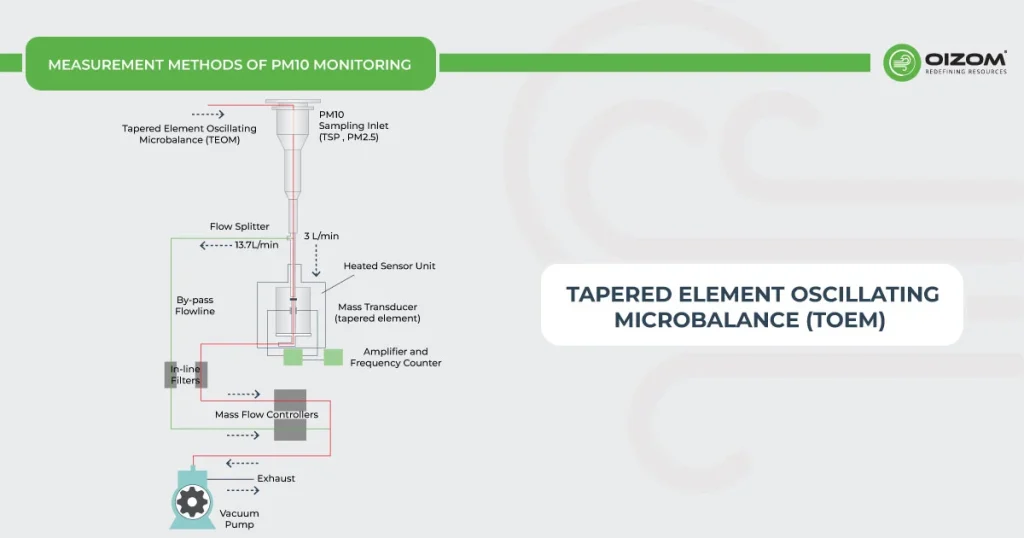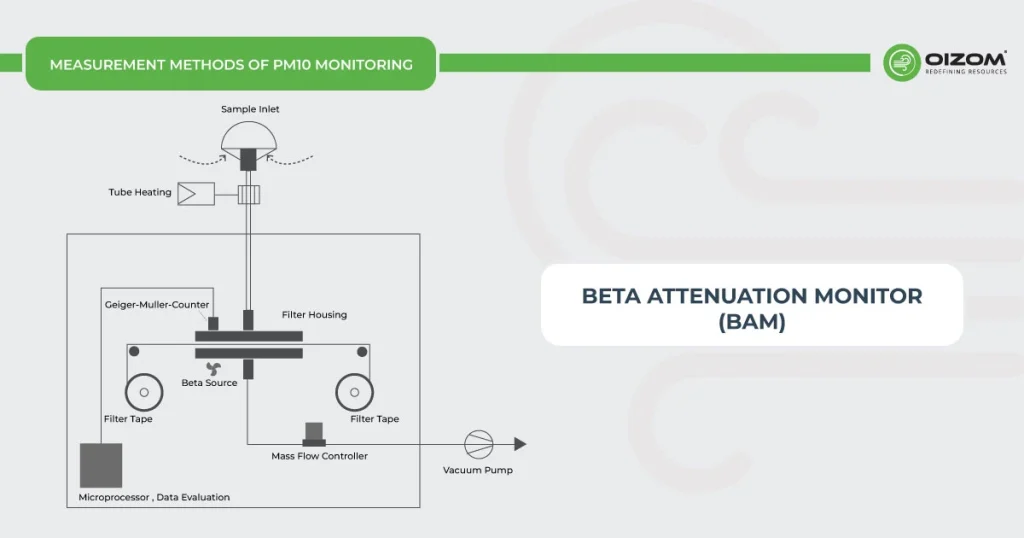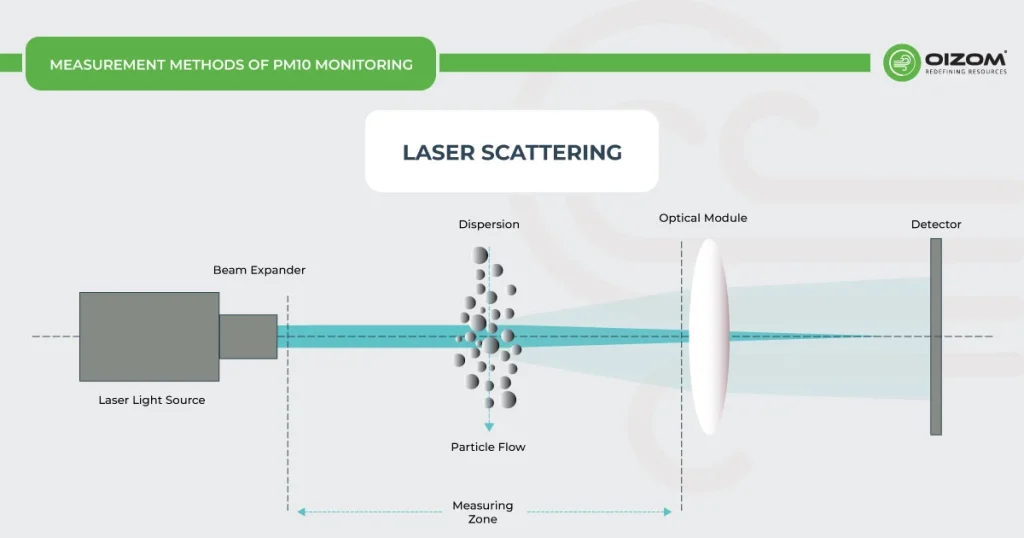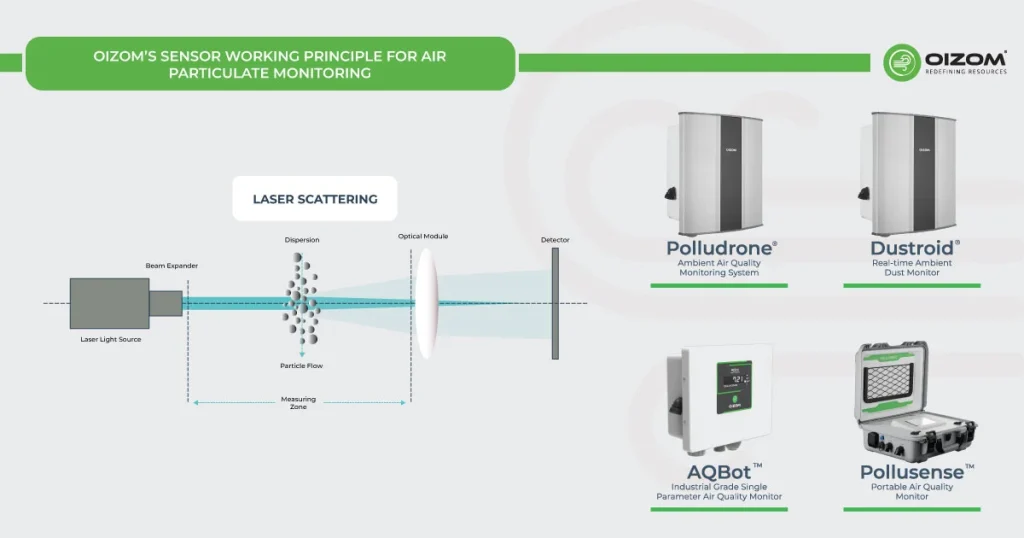1. What is PM10 or Suspended Particulate Matter (SPM)?
PM stands for particulate matter (also known as particle pollution), a mixture of solid particles and liquid droplets prevalent in the air. Dust, dirt, soot, and smoke are examples of large particles that can be seen with the naked eye. For air quality regulatory purposes, these atmospheric particles are defined by their diameter.
PM10 or Suspended Particulate Matter (SPM) describes inhalable particles with diameters generally 10 micrometers (10μm) and smaller. These particles are tiny enough to travel via the nose and throat and into the lungs. When inhaled, they can harm the heart and lungs, causing major health problems. PM10 tends to settle as it is heavier. Once released, it stays in the air for minutes or hours and travels as little as 100 meters to 50 kilometers. Examples of such coarse particles include construction dust, pollen, and mold.
At first glance, particulate matter might seem pretty simple to grasp. It’s just dust and tiny particles floating around in the air, right? There’s no need to dig out those old high school chemistry books for this one! But the reality is particulate matter is a lot more complex than it appears. Its environmental and health impacts are significant, and it’s something we should all be paying closer attention to.
So, what exactly is particulate matter (PM10)? Where does it come from? This article covers information on PM10, its sources in the ambient air, permissible levels, health and environmental impact, possible corrective measures, the need for PM10 monitors, and different methods of PM10 monitoring.
2. Sources
When we think about air pollution, we usually picture factories and power plants as the main sources. While they do contribute to particulate matter, there are plenty of other sources out there, too. In fact, particulate matter can come from both primary sources, like emissions, or secondary sources, where particles form through chemical reactions in the air.
Particulate matter PM10 is either directly emitted from a source (primary PM) or is formed through the chemical reactions of gases such as oxides of sulfur (SOx), nitrogen oxides (NOx), organic compounds, etc. in the atmosphere (secondary PM).
The natural sources of particulate matter are wind-blown dust from open land, pollen, spores, mold, dirt, soil erosion, and forest fires.
Anthropogenic sources of PM10 include:
- Burning fossil fuels such as gasoline, oil, diesel or wood,
- Waste burning
- Dust emitted from unpaved and paved roads
- Crushing and grinding of rocks
- Uncontrolled construction activities
- Dust from factories, agriculture, and landfills
- Emissions from energy supply and industrial processes
- Metal and steel production, as well as the reloading of bulk material
- Wear and tear of brakes and tires of vehicles
- Organic compounds from industrial processes and motor vehicle exhaust
3. Permissible Levels of PM10
The breakpoint concentrations describing air quality based on the PM10 concentrations for different countries are given below. In India, the daily average PM10 levels of up to 100 μg/m3 are considered satisfactory. PM10 (particulate matter with a diameter of 10 microns or less) concentrations of 15 µg/m3 annual mean, 45 µg/m3 24-hour mean. Previous WHO AQ guidelines – The Air quality guidelines by the World Health Organization suggest a 24-hr mean of 50 μg/m3.
Table: Breakpoints of PM10 (μg/m3)
|
India (24-hr) |
US (24-hr) |
China (24-hr) |
EU (8-hr) |
||||
|
AQI Category |
Break point concentration |
AQI Category |
Break point concentration |
AQI Category |
Break point concentration |
AQI Category |
Break point concentration |
|
Good |
50 |
Good |
50 |
Excellent |
50 |
Very low |
15 |
|
Satisfactory |
100 |
Moderate |
150 |
Good |
150 |
Low |
30 |
|
Moderately polluted |
250 |
Unhealthy for sensitive |
250 |
Lightly Polluted |
250 |
Medium |
50 |
|
Poor |
350 |
Unhealthy |
350 |
Moderately Polluted |
350 |
High |
100 |
|
Very Poor |
430 |
Very Unhealthy |
420 |
Heavily Polluted |
420 |
Very high |
100+ |
|
Severe |
430+ |
Hazardous |
420+ |
Severely Polluted |
420+ |
||
[Source: National Ambient Air Quality Index, CPCB (Oct 2014)]
4. Health & Environmental Impact of PM10
Health Impact
Despite being the bigger of the two PM categories, PM10 remains relatively small (less than one-tenth the width of a human hair!). PM10 particles can irritate the nose and throat tissue, causing allergic responses. Once these particles enter your lungs, PM10 irritates the lung tissue and can trigger asthma attacks. Additional conditions are:
- Stroke, high blood pressure, and heart attack
- Increased risk of lung cancer
- Reduced lung development
- Bronchitis
- Premature death
Environmental impact
Particulate matter has been found in numerous scientific studies to reduce visibility while also negatively impacting climate, ecosystems, and materials. PM, primarily PM10, affects visibility by altering how light is absorbed and scattered in the atmosphere.
Regarding climate change, specific components of the ambient PM mixture promote global warming (e.g., black carbon). In contrast, others have a cooling effect (e.g., nitrate and sulfate), resulting in ambient PM having both warming and cooling capabilities.
Additionally, settling the air-borne particles on plants, soil, and water ecosystems has harmful effects on them. The metal and organic compounds reduce plant growth and yield, while the deposition of PM into water bodies affects its quality and clarity.
5. Possible Corrective Measures
The primary step is PM10 monitoring to identify the areas with high particulate levels. You can utilize air quality alerts to protect yourself and others when PM reaches hazardous levels. In addition to this, the following corrective measures can be taken:
- Look at your local AQI readings.
- Limit outdoor activities and close windows and vents during times of high air pollution.
- Skip the morning exercise if AQI exceeds its limit.
- Wear a pollution mask.
- Eliminate the use of the fireplace, wood stove, gas-powered lawn, or garden equipment.
- Invest in an air quality monitoring system.
- Avoid areas with traffic congestion, construction activities, or unpaved roads. Breathing such polluted air daily also leads to health effects in the long run.
6. Measurement Methods of PM10 Monitoring
Different working principles for particulate matter monitoring in the ambient environment are Gravimetric, TOEM, Beta Attenuation (BAM), and Laser scattering.
High-volume Gravimetric Method – The PM10 monitors based on the gravimetric principle take in the ambient air for 24 hours at a constant flow rate through a size-selective inlet that only allows particulate matter with an aerodynamic diameter of 10µm or less to pass through. The particulate matter is collected onto a pre-weighed filter conditioned at constant temperature and humidity conditions. After the 24-hour sampling period, the filter is conditioned again under the same temperature-humidity conditions and reweighted. The difference in the weight corresponds to the mass collected on the filter, which, along with the known flow rate, sampling period, and the total volume of the air sampled, is used to calculate the PM10 concentration.
Tapered Element Oscillating Microbalance (TOEM) – It is a proprietary system for particulate matter monitoring. The PM10 monitors based on TOEM determines the PM10 concentration by continuously weighing the particulates deposited on the filter attached to a hollow tapered element that oscillates in an applied electric field. The oscillating frequency decreases with the accumulation of particulates on the filters. Thermal mass flow controllers constantly control and measure the flow rate of the PM monitor, which, along with the mass concentration, temperature, and other factors, is used to calculate the PM10 concentrations continuously.
Beta Attenuation Monitor (BAM) – The PM10 monitoring based on the BAM principle measures the particle mass density using beta radiation attenuation. The particulates in the ambient air drawn into the PM10 monitor are deposited on a paper-band filter and exposed to beta rays (i.e., electrons with energies in the 0.01 to 0.1 MeV range), which get attenuated as a function of the particulate mass. The beta count reduces with an increase in the PM10 mass, which is recorded by the detector and converted to concentration.
Laser Scattering – The PM10 monitor, based on the physical principle of light scattering, also known as optical particle counter (OPC), measures dust particles illuminated by laser light at a 90° angle. The light scattered from each particle is collected at approximately 90° by a mirror and detected by a photo-diode. This signal is then fed into a multi-channel size classifier, where a pulse height analyzer is used to classify each pulse proportional to the particle size. The counts in the channel corresponding to PM10 are converted to the concentration of PM10.
[Source from researchgate.net]
7. Oizom’s Sensor Working Principle for PM10 Monitoring
At Oizom, we offer various Particulate Matter (PM) sensors, including PM1, PM2.5, PM10, and PM100, designed for accurate air quality monitoring across various particle sizes.
Our Particulate Matter sensor module is engineered to accurately measure PM1, PM2.5, PM10, and PM100 concentrations in ambient air, providing real-time data on atmospheric particulate matter levels. The sensor’s advanced support electronics ensure compactness and reliability, making it a robust solution for continuous air quality monitoring.
These sensors work on laser scattering technology with a heated inlet to eliminate moisture and ensure accurate air quality data. Integrating a heavy-duty fan and advanced lasers guarantees precise data and durability, making these sensors ideal for outdoor applications requiring real-time air quality insights.
These advanced particulate matter sensor modules are utilized in our outdoor air quality monitoring systems, such as Polludrone and AQBot. Additionally, these modules are a key component in our specialized ambient dust monitor Dustroid. These versatile sensors are used in a variety of applications, including national air quality monitoring, environmental health impact assessments, construction site monitoring, mining, smart cities, and air quality research projects. By providing real-time particle concentration data, Oizom’s PM sensor modules support a wide array of environmental monitoring needs, ensuring accurate and reliable air quality data for diverse applications.
Our particulate monitoring sensors are calibrated with reference stations, housing Beta Attenuation Monitor, BAM-1020, which significantly enhances the data accuracy and reliability of our sensors, ensuring high-quality air quality monitoring results.
8. Why Choose Oizom PM Sensor?
- Compact: Our sensors are small and easy to install, perfect for use in any space, making them ideal for portable air quality monitoring. The PM10 sensors come pre-calibrated and can be quickly replaced in just a few minutes by removing and replacing the old sensor with a new one.
- Durable: The PM sensor has an expected lifespan of 18 months.
- The dust measurement by the laser scattering principle overestimates the PM concentration levels in condensing high humidity conditions. The data accuracy in such conditions is maintained by dehumidification of the air sample using a heated inlet.
- It reduces the relative humidity of the air sample by 30-40%, eliminating its interference in the particulate measurement.
- PM sensors work on laser-based scattering principles and Advanced algorithms.
9. Reasons Why PM10 Monitoring is Important:
- PM10 is a complex mixture of solids and aerosols with a very small size that can easily pass through the nose and throat and penetrate the lungs.
- Particulate matter is emitted into the atmosphere from vehicular exhaust, power plants, and combustion processes such as the burning of fossil fuels, waste, etc. They are also formed in the atmosphere by various chemical reactions of other air pollutants such as NOx and SOx.
- When inhaled, it irritates the eyes, nose, throat, and airways and can penetrate tissues, causing severe diseases like heart attacks, lung cancer, edema, etc., leading to premature death. , etc.
- PM10 monitoring is an efficient way to detect high particulate matter concentrations and prevent high-level exposures.
- Real-time PM10 monitoring helps determine air quality and formulate an action plan to control high levels of PM pollution.
FAQs
1. What is PM10?
PM10 refers to particulate matter with a diameter of 10 micrometers or less, small enough to be inhaled, and potentially harmful to health.
2. Why is monitoring PM10 important?
Monitoring PM10 is crucial for understanding air pollution levels, as these particles can cause respiratory and cardiovascular issues.
3.How can we reduce PM10 pollution?
Reducing PM10 involves controlling emissions from vehicles, industries, and construction sites and promoting cleaner technologies.
4.How does PM10 affect health?
PM10 particles can penetrate the lungs, leading to asthma, bronchitis, and other respiratory diseases.
5.Best Way to Monitor PM10?
Fixed Stations: Accurate but expensive. Portable Monitors: Affordable, mobile, short-term use. Satellite Data: This covers large areas but is less detailed. Citizen Sensors: Cheap, widespread, and need calibration.
6.What is the role of government in addressing PM10 pollution?
Set Limits: Define safe PM10 levels.
Regulate Sources: Control pollution from industries and vehicles.
Monitor & Enforce: Track levels and apply laws.
Raise Awareness: Educate the public on health risks.
Support Innovation: Promote eco-friendly tech.





